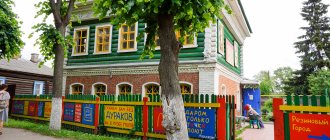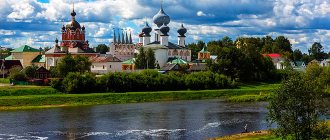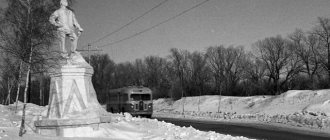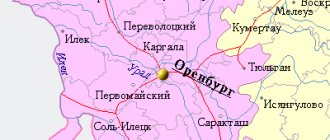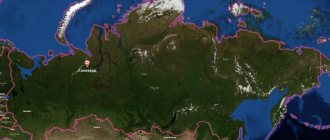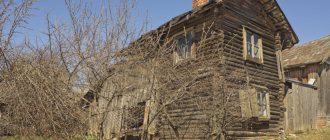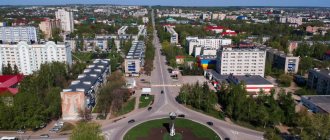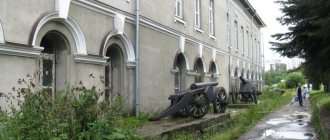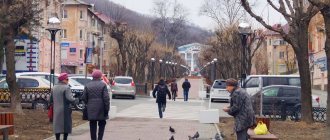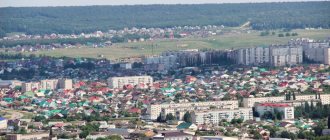Shuya on the map of Russia, geography, nature and climate
Shuya is located between the Klyazma and Volga , it is crossed from north to south by the Teza River , in addition, its tributary Sekha .
The city is located in a temperate continental climate zone with pronounced seasonal weather changes. The coldest month is January (-12.1°C), and the warmest month is July (+18.1°C). Due to the constant activity of cyclones, this area is characterized by frequent changes in weather patterns. The maximum amount of precipitation occurs in the summer.
Shuya is located at the junction of two natural zones - mixed forests and European taiga.
Routes on the map of Shuya. Transport infrastructure
A railway line runs through the city, going south to Savino, and north to Ivanovo. Shuya station receives passenger trains heading to Moscow and St. Petersburg. Also, commuter trains to Kovrov and Ivanovo pass through it.
- Shuya is located on the P152 highway connecting Rostov with Nizhny Novgorod. It provides access to the federal highways M7 and M8 .
- From north to south, the settlement is crossed by the regional highway P71 Seninskie Dvoriki-Kineshma, which joins the M7 .
Public transport runs along the city streets, and a dozen and a half bus routes have been developed.
From the local bus station you can get to many settlements in the Ivanovo region, including:
- Kineshma;
- Yuzha;
- Palekh;
- Puchezh;
- Pestyaki;
- Ivanovo.
There are also intercity routes to Moscow, Kostroma, Kovrov, Murom, Yaroslavl, transit buses go to Nizhny Novgorod, Cheboksary and Vladimir.
Attractions in the surrounding area
Shartomsky Ostrich
Address: Ivanovo region, near the village of Vvedenye Telephone: Website: https://ivstraus.ru Cost: 150 rubles How to get there: bus No. 638 Shuya-Vvedenye, from the bus station
This is a rural ostrich farm that breeds emus and African ostriches. The name of the farm is given in honor of the Nikolo-Shartomsky monastery.
The owners conduct excursions for up to 15 people, the program consists of a story about the bird, feeding cabbage to the ostriches and a visit to the shop. Here you can buy souvenirs (handmade ostrich soap) and local products (cutlets, meat, minced meat), touch ostrich skin and smear your hands with ostrich cream.
Village Dunilovo
Address: Vvedenskoye rural settlement, village. Dunilovo How to get there: bus Shuya – Dunilovo
In the 16th century, the village was larger in the number of households than Shuya. During the Time of Troubles, the residents of Dunilovo fought back against the Polish-Lithuanian invaders and put them to flight.
During the years of Soviet power, the collective farm “Path to Victory” was created.
Despite the small population, Dunilovo is home to several religious buildings; the city also houses a monument to Hero of the Soviet Union Konstantin Korablev and the merchant house of Sholonin.
The most famous complex is the Assumption Church; it included three altars: in honor of the All-Merciful Savior, in honor of the Nativity of the Blessed Virgin Mary and in honor of the Dormition of the Mother of God. The temple also kept the miraculous icon of the Smolensk Mother of God.
After the revolutionary events of 1917, a boarding school for mental patients was organized at the Assumption Monastery. The Church of the Intercession served as a hospital ward, and the altar served as a treatment room. In 1995, all religious buildings were transferred to the jurisdiction of the Holy Dormition Monastery.
Village Vvedenye
Address: Ivanovo region How to get there: bus Shuya – Vvedenye
The history of the village is connected with the Nikolo-Shartomsky monastery, the foundation of which took place in the 13th-14th centuries. The village was ruined by the Poles during the Time of Troubles. During collectivization, the Iskra collective farm was founded.
In the village there is the temple complex of the Nikolo-Shartomsky Monastery, the ensemble of the Vvedenskaya Church, the Pyatnitskaya Church and the Theological Church.
Nikolo-Shartomsky Monastery is one of the oldest monasteries in Russia. The monastery was regularly visited by Vasily III, Ivan the Terrible, and Fyodor Ioanovich. In the 1620s, the Monk Joachim of Shartom settled in the monastery, painting icons that became miraculous.
St. Nicholas Cathedral was built in 1651. During secularization under Catherine the Great, the monastery's lands were cut back.
Currently, more than 100 monks live in the complex.
Sights of the city of Shuya
The map of Shuya with streets allows you to see where all the iconic places of this ancient city are located.
- One of the most interesting places is the soap museum , where you can not only learn about the history of local soap making, but also take part in the preparation of this product yourself.
- Shuya is the birthplace of the famous Symbolist poet of the Silver Age K. Balmont, in whose memory the Literary Museum named after him operates. The museum building is an architectural monument of the pseudo-Russian style.
- Of great interest are the remains of the city prison , which has long been one of the symbols of Shuya. It became famous for its prisoners - at one time, eminent boyars of the era of Ivan the Terrible and the Soviet military leader M. Frunze were imprisoned here.
- On the territory of the city you can see a monument to the clergy and laity of the Russian Orthodox Church who fell during the years of Bolshevik persecution.
- Shuya is famous for its churches - here is the temple of St. Seraphim of Sarov , as well as the Transfiguration Cathedral.
- The Ivanovo Calico Museum will tell you about the origins, development and achievements of the craft, which has become the hallmark of the region.
Historical sites and museums
Balmont Literary and Local Lore Museum
Address: pl. Lenina, 2 Phone: Website: https://balmontmuseum.ru/ Opening hours: 10:00-17:00 Tue-Fri; 10:00-16:00 Sat, Sun; Mon – closed
The museum is located in the historical part: in the suburb next to the Kremlin. The former building of the Shuya City Duma, the style is neo-Russian.
The museum opened in 1968 to highlight local folk history. Received its current name in 2007. The museum presents various exhibitions dedicated to the nature of the region, the history of the city, and the life and work of the poet.
The exhibition presents the pedigree of the Balmont family, documents and photographs of the poet and his parents, collections published during his lifetime, cutlery with initials, and a silver pen. The museum also houses collections of porcelain, works by Makovsky and Levitan.
Since 1989, the museum has hosted Balmont readings, competitions and children's festivals, and master classes.
Shuya Museum and Cultural Center named after. M. V. Frunze
Address: st. M. Belova 11/13 Phone: 8 (49351) 3-86-20 Opening hours: 10.00-17.00 Tue-Fri; 10.00-15.00 Sat, Sun; Mon – closed
One of the oldest museums in the Ivanovo region, unique in its profile - a revolutionary museum dedicated to the life of M. V. Frunze, a Soviet figure and revolutionary.
The main exhibition of the museum is “Time and Fate”, dedicated to the history of the city and the activities of the Red Guard. Collections include Frunze's photo-documentary collection and posters from the World Festival of Youth and Students (1957), held in Moscow. Also presented is a model of the Shuya Kremlin of the 15th century.
The museum's funds contain works by Soviet artists, collections of bottles from the 19th and 20th centuries, posters, and stamps.
Soap Museum
Address: 2nd Dubkovskaya, 33A Telephone: Website: https://milce.ru/ Working hours: 10:00-17:00 Sat-Sun, on weekdays - by agreement
The museum opened in 2014. Soap making in Shuya began in the 17th century; in total there were more than 10 soap factories.
Under Catherine the Great, the whole country knew about the excellent quality of local soap. The coat of arms, approved in 1781, confirms this fact.
The museum's collection contains ancient recipes and the official seal of the chairman of the nobility. The museum conducts master classes on soap making (from 10 people), and since 2010 the city has hosted a soap festival.
Museum State Wine Warehouse No. 3
Address: st. Zavokzalnaya, 17 Telephone: Opening hours: 10:00-17:00 Mon-Sat, Sun – closed
The history of the production of alcoholic beverages in Shuya is presented in this museum. Despite the small size of the exhibition, ancient recipes, a collection of equipment and bottles are stored here.
A company store is located nearby, attracting a large number of customers.
The group tour includes a visit to the production facility, a film and a tasting.
Pavlovsky Cultural Center (Estate of manufacturer M. A. Pavlov)
Address: 1st Moskovskaya, 38 Telephone: 8 (49351) 4-84-98 Opening hours: 8:00-18:00 Mon-Sun Cost: 60 rub.
The architectural landmark of Shuya, a monument of the 19th century, has preserved the internal and external appearance of that time.
The building was built in a palace style, which is rare for provincial cities. The complex is dedicated to the life and work of M. A. Pavlov, philanthropist, merchant and industrialist. He provided jobs for hundreds of townspeople, built churches and provided assistance to schools.
The cultural complex hosts theatrical performances, charity evenings, receptions of official delegations, classical music evenings and children's parties.
Water tower
Address: st. Sverdlova 1/36
In 1883, one of the first water pipes in the Russian Empire was opened in Shuya, funded by donations from residents. The architect of the tower was V. O. Sherwood, the author of the Historical Museum in Moscow.
The tower is a water temple decorated with brickwork. The style of construction is Russian.
For some time the tower was used as fire protection.
Cart scales
Address: Central Market Address: Central Market
The building, built at the end of the 18th century in the style of late classicism, has a general appearance similar to an ancient Greek temple.
Built to determine the weight of carts with goods. In Shuya, scales were considered “zero kilometer”: the flagpole rising on the building had the appearance and color of a milepost.
Restoration work began in 2007, and now the scales are one of the city’s decorations.
Remains of the prison castle
Address: st. Soyuznaya, 15
The first information about the city prison (prison) is found in documents of the 16th-17th centuries. The structure was located on the site of salt barns.
The prison building was destroyed several times by fires and by the Poles, after which it was restored and rebuilt. There is a stone church near the prison, built at the expense of the merchant I. S. Gundobin.
Famous historical figures whiled away their time within the walls of the fort: the boyars of Ivan the Terrible, opponents of Boris Godunov, revolutionary M. V. Frunze. Today the building is used for commercial purposes.
Main streets of Shuya
On the map of Shuya with houses you can find all 363 streets and avenues, as well as over three thousand buildings and structures. Among the main ones are:
- Lenin Street is one of the central city highways. It starts from the connection of Komsomolskaya and Vasilyevskaya streets, and at the end it turns into the Vasilievsky tract. The Passage, the central market and the city library are located in this area.
- Sovetskaya Street was once called Millionnaya because of the large number of rich houses of the local nobility. Here is the building of the municipal administration, a memorial to soldiers who fell during the Great Patriotic War, as well as the first monument to M. Frunze erected in the country.
- General Belov Street - named after a fellow countryman, a famous military figure who took part in the defense of Tula. Passes by the Temple of Xenia of St. Petersburg.
- Sverdlova Street (formerly called Kovrovskaya) starts from Green Square, where the monument to the clergy who died for the faith is located; nearby is the five-tiered stone bell tower of the Resurrection Cathedral.
Churches and Temples
Bell tower and Resurrection Cathedral
Address: Green Square, 4
The most famous religious building is Shuya. The temple was founded in 1799; the townspeople made a great contribution to the construction: they actively collected donations.
The belfry, 106 m high, is recognized as one of the tallest in Russia, standing separately from the cathedral.
The construction of the temple was entrusted to Maricelli, who was invited from Italy, but the supporting structure of one of the tiers could not stand it. The foreign master fled in fear. Construction was transferred to the simple peasant Savvatyev and the architect Petrov. The image of the Shuya Bell Tower was placed on the labels and logos of local enterprises.
Church of the Intercession
Address: Soyuznaya, 1
The construction of the temple took place in 1754 on the site of a wooden cathedral church. Previously, in ancient times, there was a cemetery next to the cathedral.
In the 17th century there were two churches on the territory: Aleksievskaya and Pokrovskaya. The Church of the Intercession kept an ancient selection of icons (XVI-XVIII centuries), the library contained a collection of royal manifestos, decrees and the Gospel of the 16th century.
